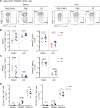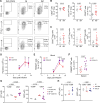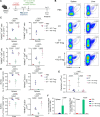CD39 expression by regulatory T cells participates in CD8+ T cell suppression during experimental Trypanosoma cruzi infection
- PMID: 38683845
- PMCID: PMC11081507
- DOI: 10.1371/journal.ppat.1012191
CD39 expression by regulatory T cells participates in CD8+ T cell suppression during experimental Trypanosoma cruzi infection
Abstract
An imbalance between suppressor and effector immune responses may preclude cure in chronic parasitic diseases. In the case of Trypanosoma cruzi infection, specialized regulatory Foxp3+ T (Treg) cells suppress protective type-1 effector responses. Herein, we investigated the kinetics and underlying mechanisms behind the regulation of protective parasite-specific CD8+ T cell immunity during acute T. cruzi infection. Using the DEREG mouse model, we found that Treg cells play a role during the initial stages after T. cruzi infection, restraining the magnitude of CD8+ T cell responses and parasite control. Early Treg cell depletion increased the frequencies of polyfunctional short-lived, effector T cell subsets, without affecting memory precursor cell formation or the expression of activation, exhaustion and functional markers. In addition, Treg cell depletion during early infection minimally affected the antigen-presenting cell response but it boosted CD4+ T cell responses before the development of anti-parasite effector CD8+ T cell immunity. Crucially, the absence of CD39 expression on Treg cells significantly bolstered effector parasite-specific CD8+ T cell responses, preventing increased parasite replication in T. cruzi infected mice adoptively transferred with Treg cells. Our work underscores the crucial role of Treg cells in regulating protective anti-parasite immunity and provides evidence that CD39 expression by Treg cells represents a key immunomodulatory mechanism in this infection model.
Copyright: © 2024 Araujo Furlan et al. This is an open access article distributed under the terms of the Creative Commons Attribution License, which permits unrestricted use, distribution, and reproduction in any medium, provided the original author and source are credited.
Conflict of interest statement
The authors have declared that no competing interests exist.
Figures







Update of
-
CD39 expression by regulatory T cells drives CD8+ T cell suppression during experimental Trypanosoma cruzi infection.bioRxiv [Preprint]. 2023 Sep 16:2023.09.14.557792. doi: 10.1101/2023.09.14.557792. bioRxiv. 2023. Update in: PLoS Pathog. 2024 Apr 29;20(4):e1012191. doi: 10.1371/journal.ppat.1012191. PMID: 37745571 Free PMC article. Updated. Preprint.
References
Publication types
MeSH terms
Substances
Grants and funding
LinkOut - more resources
Full Text Sources
Medical
Molecular Biology Databases
Research Materials

